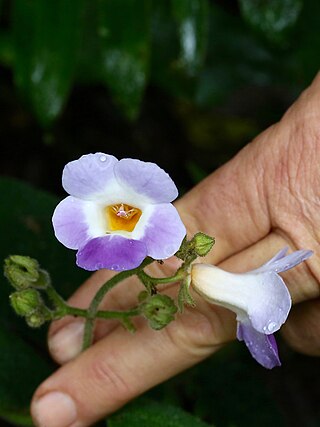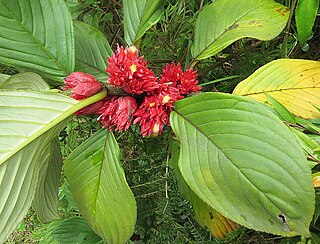
Gesneriaceae, the gesneriad family, is a family of flowering plants consisting of about 152 genera and ca. 3,540 species in the tropics and subtropics of the Old World and the New World, with a very small number extending to temperate areas. Many species have colorful and showy flowers and are cultivated as ornamental plants.

Browneopsis is a genus of flowering plants in the family Fabaceae. There are about 8 species of trees native to South America, ranging from Panama through Colombia and Ecuador to Peru and northern Brazil. Species typically grow in lowland tropical rain forests, including inundated and terra firme forests, and in sub-montane forests in the foothills of the Andes.
Glossoloma herthae is a plant species in the family Gesneriaceae. A recent review has moved it out of the genus Alloplectus.
Glossoloma martinianum is a plant species in the family Gesneriaceae. A recent review has moved it out of the genus Alloplectus.
Glossoloma penduliflorum is a plant species in the family Gesneriaceae. A recent review has moved it out of the genus Alloplectus.

Monopyle is a genus of plants in the family Gesneriaceae.
Trichodrymonia aurea is a species of plant in the family Gesneriaceae. It is endemic to Ecuador. Its natural habitat is subtropical or tropical moist montane forests.
Trichodrymonia binata is a species of plant in the family Gesneriaceae. It is endemic to Ecuador. Its natural habitat is subtropical or tropical moist montane forests.
Trichodrymonia lacera, formerly Paradrymonia lacera, is a species of plant in the family Gesneriaceae. It is a terrestrial or epiphytic herb endemic to western Ecuador. Its natural habitat is tropical moist foothill and montane forest from 500 to 1,000 meters elevation. It is known from two collections in Cotopaxi Province. It may be extinct in the wild, but has been cultivated.

Reldia is a genus of plants in the family Gesneriaceae. They are also in the Beslerieae tribe.

Glossoloma is a genus of Neotropical plants in the family Gesneriaceae. The species in the genus were formerly placed in Alloplectus. They are subshrubs with the leaves clustered at the ends of branches, and tubular flowers.
Sanango is a genus of flowering plants containing a single species, Sanango racemosum. The genus was originally placed in family Loganiaceae but has since been variously placed in Scrophulariaceae, Gesneriaceae and Buddlejaceae. As of 2016 it is considered to be the sister genus to the family Gesneriaceae as previously defined, and the family was tentatively enlarged to include the genus, pending a revision of the families included in Lamiales. It has been placed as the only genus in the monotypic subfamily Sanangoideae.
Fieldia australiana is a species of flowering plant in the family Gesneriaceae. It is a small tree from eastern Australian rainforests. It has also been placed as the sole species in the monotypic genus Lenbrassia.

Codonanthopsis is a genus of flowering plants in the family Gesneriaceae. Its native range is from southern Mexico through tropical America to Bolivia and most of Brazil. Codonanthopsis species are generally trailing epiphytes with pale flowers. Most have a mutualistic relationship with tree-living ants: the plants provide the ants with food, including nectar, and give their nests structure and support, while the ants disperse the plants' seeds. The genus was considerably expanded in 2013 when species were transferred from Codonanthe. Some Codonanthopsis species are cultivated as houseplants, when they may be grown in hanging baskets.
Coptocheile is a monotypic genus of flowering plants possibly belonging to the family Gesneriaceae. Its only species is Coptocheile macrorhiza. It is native to Brazil.
Lesia is a genus of flowering plants in the family Gesneriaceae, subfamily Gesnerioideae.

Fieldia is a genus of flowering plants in the family Gesneriaceae, native to New South Wales, Queensland and Victoria in Australia. It has at times been treated as monotypic, with one species, F. australis. Two are accepted as of April 2021 by sources that include Lenbrassia in Fieldia.
Pachycaulos is a genus of flowering plants belonging to the family Gesneriaceae. It has two species, Pachycaulos nummularia and Pachycaulos huancabambae. Its native range is Southeastern Mexico to Peru.
Resia is a genus of plants in the family Gesneriaceae. They are also in the Beslerieae tribe.

Anthurium ernestii is a species of plant in the genus Anthurium native to South America. Found from southern Colombia to Peru and western Brazil, it typically grows below 500 metres (1,600 ft).







